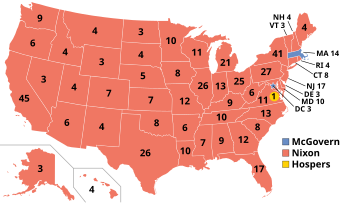| ← 1970 1971 1972 1973 1974 → Presidential election year | |
| Election day | November 7 |
|---|---|
| Incumbent president | Richard Nixon (Republican) |
| Next Congress | 93rd |
| Presidential election | |
| Partisan control | Republican hold |
| Popular vote margin | Republican +23.2% |
| Electoral vote | |
| Richard Nixon (R) | 520 |
| George McGovern (D) | 17 |
 | |
| 1972 presidential election results. Red denotes states won by Nixon, blue denotes states won by McGovern. Numbers indicate the electoral votes won by each candidate. | |
| Senate elections | |
| Overall control | Democratic hold |
| Seats contested | 34 of 100 seats (33 seats of Class 2 + 2 special elections) |
| Net seat change | Democratic +2 |
 | |
| 1972 Senate results
Democratic gain Democratic hold | |
| House elections | |
| Overall control | Democratic hold |
| Seats contested | All 435 voting members |
| Popular vote margin | Democratic +5.6% |
| Net seat change | Republican +12 |
 | |
| 1972 House of Representatives results
Democratic gain Democratic hold | |
| Gubernatorial elections | |
| Seats contested | 20 (18 states, 2 territories) |
| Net seat change | Democratic +1 |
 | |
| 1972 gubernatorial election results Territorial races not shown Democratic gain Democratic hold | |
The 1972 United States elections were held on November 7, and elected the members of the 93rd United States Congress. The election took place during the later stages of the Vietnam War. The Republican Party won a landslide victory in the presidential election, and picked up seats in the House, but the Democratic Party easily retained control of Congress. This was the first election after the ratification of the 26th Amendment granted the right to vote to those aged 18–20.
Incumbent Republican President Richard Nixon won re-election, defeating Democratic Senator George McGovern from South Dakota. Nixon won a landslide victory, taking just under 61% of the popular vote and winning every state but Massachusetts and Washington, D. C. Libertarian John Hospers won the electoral vote of one faithless elector. McGovern won the Democratic nomination, after defeating Washington Senator Henry M. Jackson, Alabama Governor George Wallace, and New York Congresswoman Shirley Chisholm. This was the first presidential election after the McGovern–Fraser Commission (which McGovern himself had chaired) caused an increase in the number of states holding primary elections.
In the House, the Republican Party picked up twelve seats, but Democrats easily retained a majority. In the Senate, the Democratic Party picked up two seats, increasing their majority. The House elections took place after the 1970 United States census and the subsequent congressional re-apportionment.
In the gubernatorial elections, Democrats won a net gain of one seat.
See also
- 1972 United States presidential election
- 1972 United States House of Representatives elections
- 1972 United States Senate elections
- 1972 United States gubernatorial elections
- 1970 United States redistricting cycle
References
- The Class 2 Senate seat in Georgia held concurrent regular and special elections in November 1972. That special election is not included in the total number of seats contested.
- "Statistics of the Presidential and Congressional Election of November 7, 1972" (PDF). U.S. House of Reps, Office of the Clerk. Retrieved April 10, 2017.
- "1972 Presidential Election". The American Presidency Project. Retrieved August 13, 2011.
- Schulman, Bruce (October 25, 2015). "McGovern: Forging a modern political party". Reuters. Archived from the original on October 28, 2012. Retrieved September 8, 2015.
This American elections-related article is a stub. You can help Misplaced Pages by expanding it. |